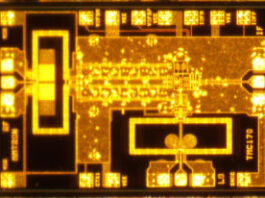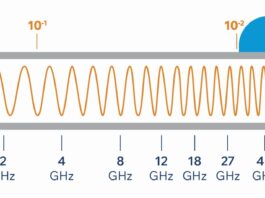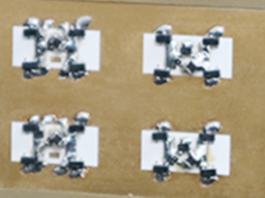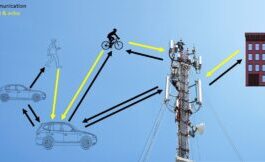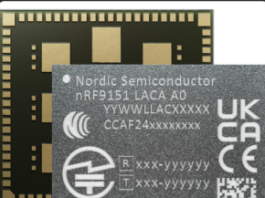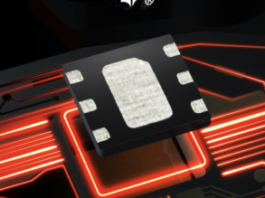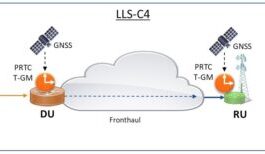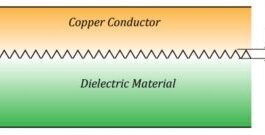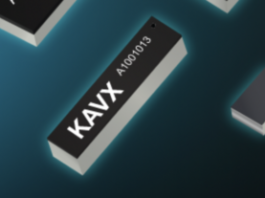
EE World went inside this one-of-a-kind truck that brings many forms of connectivity to first responders.
Boston — When disaster strikes in the form of a hurricane, flood, fire, or other situation, communication often gets cut off. First responders and rescue crews need communications to coordinate their efforts and see situations as they develop.
Also read: EE Students Get A New RF Lab Full Of Test Equipment

Figure 1. Thor has a six-door cab with screens on the doors.
In response to that need, Verizon has some 500 deployable assets that provide communications. Then there’s the Tactical Humanitarian Operations Response (THOR), the “Swiss Army Knife” of rolling telecom that provides wireless and wired communication services. It’s a prototype that shows what’s possible in terms of communications for disaster areas. EE World went inside for a firsthand look when THOR visited the Verizon facility at Boston’s North Station on September 28, 2022. The company put on a seminar for first responders that day, but this is what the attendees really wanted to see.
Built upon a Ford F-650 chassis with 45-in. tires, THOR brings LTE and 5G wireless, mobile edge computing, Wi-Fi, and Ethernet connectivity to areas where regular service is down or doesn’t exist. It brings an entire 4G/5G/mmWave private network to the scene. That network can connect to the internet over a satellite link when needed.
Also read: Here Is An Amazing Free Tool And Website That Can Make Your Windows Look Cool For Free
THOR is one of over 500 deployable assets in the Verizon fleet that the company can deploy. What makes THOR different is that it encompasses just about every tool that Verizon can install in one vehicle. It has a private network with its own core, that’s different from other Verizon Frontline assets, which use the company’s public network. Other assets are subsets of THOR.

Figure 2. Screens inside the cab provide valuable information about the scene.
Thor has a six-door cab that holds up to six people (Figure 1). Five of those seats are equipped with screens for network engineers and field engineers (Figure 2) to configure and maintain the network during deployment. Screens inside the open doors let others see what’s going on in the field. Seats also have space for laptops. THOR has a total of 12 screens.
Who rides in THOR?
The expertise and number of people needed in the cab depending on the deployment situation. If THOR need only to provide additional capacity, for example, you wouldn’t need to use all the space it has available. You may only need one or two people. If, however, it was being used to both provide connectivity and serve as an ad-hoc command center during a wildfire response effort in a remote area, you would need the additional space and capabilities. That includes the drone and its pilot for situational awareness. The nature of the response dictates the personnel needed.
Also read: Lens Antennas Focus Multiple Wireless Beams
THOR’s command center (Figure 3) sits behind the cab. When deployed, THOR can hold an additional three people there.

Figure 3. The control center contains a RAN, servers, a network core, and video distribution.
In the command center, racks of equipment hold routers, a 4G/5G radio access network (RAN), servers, a non-standalone (NSA) network core, video distribution, a satellite video controller, a firewall, and all the cables and power supplies needed to keep everything running. Here, people can monitor operations and communications passing through THOR. Images from the scene can be sent to the door screens as well. “We have a network core and applications that we can bring to a disaster site,” said Verizon’s Carlo Thompson. “We also have backhaul connectivity because we have to connect any user that comes to the vehicle, be that through cellular, Wi-Fi, or Ethernet.” The backhaul can be satellite through the dish or it can be over a mmWave link.
The outside of the truck (Figure 4) contains antennas on telescoping towers, lighting, a satellite dish, and a drone. As you might expect, the drone provides aerial views of the situation. It can operate under automated or manual control. The towers and dish were folded for THOR to fit into the building’s loading dock. When deployed, the towers can reach 50 ft. in height. The dish provides an internet connection from a satellite, the main exit out of the private network. That lets users at the scene send and receive data when there’s no public network connection available. Note the three white antennas atop the truck. They provide the mmWave backhaul connection to Verizon’s network. For connecting to people at the scene, THOR can use any of Verizon’s licensed 4G and 5G bands. A dome antenna receives satellite TV, which lets people at the scene view news reports.

Figure 4. Thor’s roof holds a satellite dish, cellular and Wi-Fi antennas, a drone, and lighting fixtures.
Where does the power come from? THOR can connect to the power grid, but that’s often not available on the scene. Two onboard generators provide power for the equipment, which gets its energy from two 80-gal diesel fuel tanks. The generators can run for up to 150 hours. You can see the tanks in Figure 1 under the doors.
THOR may be the only one of its kind in the Verizon fleet, but as Thompson noted, technology evolves. “THOR is not a finished product. We spoke to first responders and to people at DoD. Everything on this truck shows the art of the possible. If you just need voice and data, say in a wildfire situation, we can deliver a smaller asset. We often do that. THOR is everything on the menu. It’s a prototype to show what’s possible. Other vehicles may be built with different combinations of capabilities.
Also read: Nordic IC Adds Wi-Fi To IoT Devices
Immediately after this stop in Boston, THOR left for southwest Florida to assist in relief efforts following Hurricane Ian.
In the video below, Thompson provides a tour inside and outside THOR.


